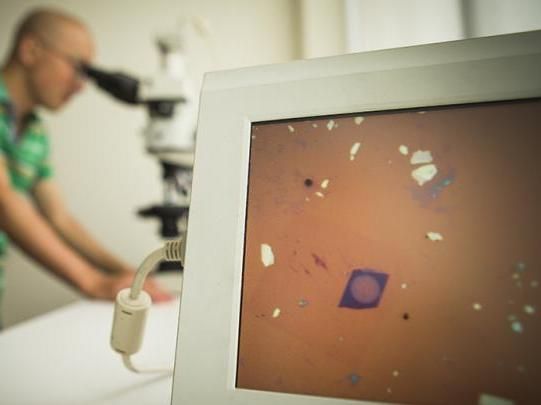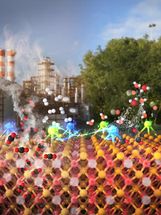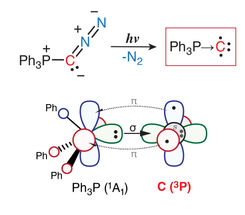World's thinnest lens to revolutionize cameras
Scientists have created the world's thinnest lens, one two-thousandth the thickness of a human hair, opening the door to flexible computer displays and a revolution in miniature cameras.

JiongYang examines the lens (purple circle on screen).
Stuart Hay, ANU
Lead researcher Dr Yuerui (Larry) Lu from The Australian National University (ANU) said the discovery hinged on the remarkable potential of the molybdenum disulphide crystal.
"This type of material is the perfect candidate for future flexible displays," said Dr Lu, leader of Nano-Electro-Mechanical System (NEMS) Laboratory in the ANU Research School of Engineering.
"We will also be able to use arrays of micro lenses to mimic the compound eyes of insects."
The 6.3-nanometre lens outshines previous ultra-thin flat lenses, made from 50-nanometre thick gold nano-bar arrays, known as a metamaterial.
"Molybdenum disulphide is an amazing crystal," said Dr Lu
"It survives at high temperatures, is a lubricant, a good semiconductor and can emit photons too.
"The capability of manipulating the flow of light in atomic scale opens an exciting avenue towards unprecedented miniaturisation of optical components and the integration of advanced optical functionalities."
Molybdenum disulphide is in a class of materials known as chalcogenide glasses that have flexible electronic characteristics that have made them popular for high-technology components.
Dr Lu's team created their lens from a crystal 6.3-nanometres thick - 9 atomic layers - which they had peeled off a larger piece of molybdenum disulphide with sticky tape.
They then created a 10-micron radius lens, using a focussed ion beam to shave off the layers atom by atom, until they had the dome shape of the lens.
The team discovered that single layers of molybdenum disulphide, 0.7 nanometres thick, had remarkable optical properties, appearing to a light beam to be 50 times thicker, at 38 nanometres. This property, known as optical path length, determines the phase of the light and governs interference and diffraction of light as it propagates.
"At the beginning we couldn't imagine why molybdenum disulphide had such surprising properties," said Dr Lu.
Collaborator Assistant Professor Zongfu Yu at the University of Wisconsin, Madison, developed a simulation and showed that light was bouncing back and forth many times inside the high refractive index crystal layers before passing through.
Molybdenum disulphide crystal's refractive index, the property that quantifies the strength of a material's effect on light, has a high value of 5.5. For comparison, diamond, whose high refractive index causes its sparkle, is only 2.4, and water's refractive index is 1.3.
Original publication
Most read news
Other news from the department science

Get the chemical industry in your inbox
By submitting this form you agree that LUMITOS AG will send you the newsletter(s) selected above by email. Your data will not be passed on to third parties. Your data will be stored and processed in accordance with our data protection regulations. LUMITOS may contact you by email for the purpose of advertising or market and opinion surveys. You can revoke your consent at any time without giving reasons to LUMITOS AG, Ernst-Augustin-Str. 2, 12489 Berlin, Germany or by e-mail at revoke@lumitos.com with effect for the future. In addition, each email contains a link to unsubscribe from the corresponding newsletter.


















































